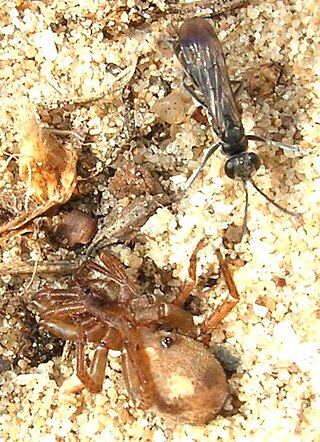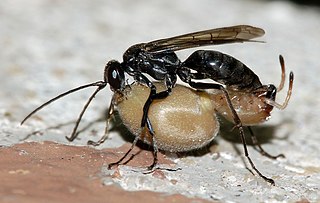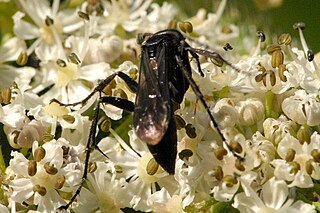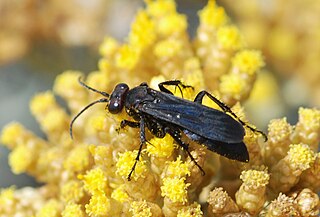
Wasps in the family Pompilidae are commonly called spider wasps, spider-hunting wasps, or pompilid wasps. The family is cosmopolitan, with some 5,000 species in six subfamilies. Nearly all species are solitary, and most capture and paralyze prey, though members of the subfamily Ceropalinae are kleptoparasites of other pompilids, or ectoparasitoids of living spiders.

Episyron rufipes, the red-legged spider wasp, is a red and black or completely black spider-hunting wasp.

The Pompilinae are a subfamily of the spider wasp family, Pompilidae, the species of which lay their eggs on the paralyzed bodies of their prey.

Pompilus is a genus of spider wasps in the family Pompilidae, the members of which prey on spiders. There are seven species recognised in Pompilus sensu stricto. It is the type genus of the family Pompilidae and the subfamily Pompilinae.
Dipogon bifasciatus is a spider wasp from the family Pompilidae.

Dipogon variegatus is a pompilid spider wasp in the subfamily Pepsinae from the Palearctic.

Auplopus carbonarius is a spider wasp of the family Pompilidae. Uniquely among the British group it constructs a nest of barrel-shaped cells in which spiders are stored and the larvae develop.

Cryptocheilus is a genus of spider wasps of the subfamily Pepsinae, they are found in the world's warmer regions. They vary in size from medium to large and are often strikingly coloured. The females construct multicellular nests in cavities, once built each cell is stocked with a spider, captured by the female. They are found in open habitats such as heaths, meadows and forest edges.

Anoplius nigerrimus is a species of spider wasp, or pompilid, and is the type species of the genus Anoplius.

Aporus is a genus of spider wasps from the family Pompilidae, they specialise in hunting ground dwelling spiders in their burrows for laying eggs on.

Priocnemis monachus is a species of spider wasp endemic to New Zealand, where it is known as the black hunting wasp or ngaro wīwī. It hunts large tunnelweb or trapdoor spiders, paralysing them with its sting and storing them in burrows for its larvae to eat alive. It is the largest member of the family Pompilidae in New Zealand.

Evagetes is a genus of spider wasps from the family Pompilidae. There are 72 described species, of which 58 are found in the Palaearctic region, 11 in the Nearctic region, with a few penetrating to the Afrotropical, Oriental and Neotropic regions. Evagetes wasps are kleptoparasitic on other pompilid wasps, especially the genera Arachnospila, Anoplius, Episyron and Pompilus, digging into their sealed burrows, eating the host egg and replacing it with an egg of its own. Evagetes wasps are characterised by their very short antennae. Most are species are black with the base of the antennae rufous, several Evagetes species are very metallic bluish insects.
Evagetes crassicornis is a kleptoparasitic spider wasp with a holarctic distribution.

Agenioideus is a genus of spider wasps from the subfamily Pompilinae; the genus occurs in Europe, where 21 species are recorded, eastwards to Japan, in North America, South America, and Australia.

Agenioideus cinctellus is a spider wasp of the subfamily Pompilinae with a Palearctic distribution.

Caliadurgus is a genus of spider wasps of the subfamily Pepsinae. These are medium-sized black spider wasps with some red. They have a catholic habitat choice and their preferred prey are spiders of the families Araneidae and Tetragnathidae. They have a Holarctic and Neotropical distribution.

Tachypompilus ferrugineus, the rusty spider wasp, red-tailed spider hunter, or sometimes red-tailed spider wasp is a species of spider wasp from the Americas. It preys mainly on wandering spiders, especially wolf spiders.
The red-tailed spider hunter is a species of spider wasp from western North America.
Paracyphononyx is a genus of spider wasps distributed in the tropics and warmer temperate regions; they differ from other pompilids in that they do not permanently disable the host spider but allow the spider to resume activity after the wasp has laid its egg on the spider while the wasp larva exists as koinobiont ectoparasitoid of the spider.

Ageniellini, known as the mud-nesting spider wasps, is a tribe of spider wasps in the subfamily Pepsinae.
















